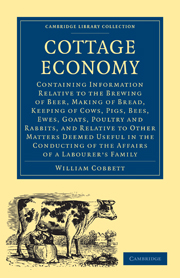Book contents
- Frontmatter
- Contents
- 1 Introduction. To the Labouring Classes of this Kingdom.—Brewing Beer
- 2 Brewing Beer continued
- 3 Making Bread
- 4 Making Bread continued.—Brewing Beer.—Keeping Cows
- 5 Keeping Cows
- 6 Keeping Pigs.—Salting Mutton and Beef
- 7 Bees, Geese, Ducks, Turkeys, Fowls, Pigeons, Rabbits, Goats and Ewes, Candles and Rushes, Mustard. Dress and Household Goods and Fuel, Hops and Yeast
- INDEX
4 - Making Bread continued.—Brewing Beer.—Keeping Cows
Published online by Cambridge University Press: 29 August 2010
- Frontmatter
- Contents
- 1 Introduction. To the Labouring Classes of this Kingdom.—Brewing Beer
- 2 Brewing Beer continued
- 3 Making Bread
- 4 Making Bread continued.—Brewing Beer.—Keeping Cows
- 5 Keeping Cows
- 6 Keeping Pigs.—Salting Mutton and Beef
- 7 Bees, Geese, Ducks, Turkeys, Fowls, Pigeons, Rabbits, Goats and Ewes, Candles and Rushes, Mustard. Dress and Household Goods and Fuel, Hops and Yeast
- INDEX
Summary
101. IN the last Number, at paragraph 86, I observed, that I hoped it was unnecessary for me to give any directions as to the mere act of making bread. But, several correspondents inform me, that, without these directions, a conviction of the utility of baking bread at home is of no use to them. Therefore, I shall here give those directions, receiving my instructions here from one, who, 1 thank God, does know how to perform this act.
102. Suppose the quantity be a bushel of flour. Put this flour into a trough that people have for the purpose, or, it may be in a clean smooth tub of any shape, if not too deep, and sufficiently large. Make a pretty deep hole in the middle of this heap of flour. Take (for a bushel) a pint of good fresh yeast, mix it and stir it well up in a pint of soft water milk-warm. Pour this into the hole in the heap of flour. Then take a spoon and work it round the outside of this body of moisture so as to bring into it by degrees flour enough to make it form a thin batter, which you must stir about well for a minute or two. Then take a handful of flour and scatter it thinly, over the head of this batter, so as to hide it. Then cover the whole over with a cloth to keep it warm; and this covering, as well as the situation of the trough as to distance from the fire must depend on the nature of the place and state of the weather as to heat and cold.
- Type
- Chapter
- Information
- Cottage Economy , pp. 73 - 96Publisher: Cambridge University PressPrint publication year: 2009First published in: 1822



